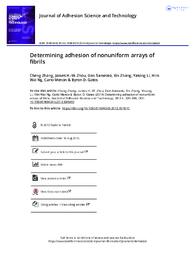Gates, Byron D.
Person Preferred Name
Byron D. Gates
Related Works
Content type
Digital Document
Abstract
Dry adhesives containing nonuniform arrays of fibrils were tested for the uniformity of their adhesion strength. These arrays comprised fibrils with nanometer-scale dimensions and lengths tuned from 150 to 1500 nm. The surfaces of the fibrils were rendered hydrophobic through a vapor phase deposition of silane molecules to further tune the adhesion strength of the fibrillar structure. Adhesion force measurements over micrometer-length scales were obtained using a tipless cantilever controlled by a scanning probe microscope. Maps of the adhesion forces depicted diverse variations in adhesion strength with the nonuniform lateral changes in topography. Through an extensive data analysis, differences observed between samples were correlated to changes in processing conditions and surface chemistry modifications. The methods demonstrated in this paper are useful for identifying variations in the adhesion strength of dry adhesives made of nonuniform arrays of fibrils. These advancements are crucial for understanding the correlation between structure and function within nonuniform fibrillar adhesives.
Origin Information
Content type
Digital Document
Abstract
The natural ability of geckos and spiders to climb almost all surfaces using the compliant, nano-structured components on their feet provides motivation for making bio-inspired adhesives. The goal of the studies in this paper is to create an analytical technique for improving the ability to characterize dry adhesives modeled after these biological systems. The technique described herein uses a scanning probe microscope to manipulate a flat test surface in contact with biomimetic fibrillar arrays while monitoring the adhesion forces. Adhesion forces were measured after both normal contact and shear-induced contact between the nano-structured fibrils and the test surface. Results confirm that the adhesion forces are higher for bio-inspired adhesives after a shear-induced contact. Variations in these forces can be measured across the sample with micrometer-scale lateral resolution. This method of analysis can be extended to evaluate bio-inspired dry adhesives with realistic mechanisms of attachment utilized in robotic and similar applications of these materials.
Origin Information
Content type
Digital Document
Abstract
The hierarchical arrays of mesoscale to nanoscale fibrillar structures on a gecko’s foot enable the animal to climb surfaces of varying roughness. Adhesion force between the fibrillar structures and various surfaces is maximized after the gecko drags its foot in one direction, which has also been demonstrated to improve the adhesion forces of artificial fibrillar arrays. Essential conditions that influence the magnitude of these interactions include the lateral distance traveled and velocity between the contacting surfaces, as well as the velocity at which the two surfaces are subsequently separated. These parameters have, however, not been systematically investigated to assess the adhesion properties of artificial adhesives. We introduce a systematic study that investigates these conditions using a scanning probe microscope to measure the adhesion forces of artificial adhesives through a process that mimics the mechanism by which a gecko climbs. The measured adhesion response was different for arrays of shorter and longer fibrils. These results from 9000 independent measurements also provide further insight into the dynamics of the interactions between fibrillar arrays and contacting surfaces. These studies establish scanning probe microscopy techniques as a versatile approach for measuring a variety of adhesion properties of artificial fibrillar adhesives.
Origin Information
Content type
Digital Document
Abstract
It is important that all workers understand the health and safety risks of their work environment. It has been demonstrated that exposure to nanoparticles can lead to potential health concerns. A 1 mL nanoparticle solution spill can contain >10^9 nanoparticles, with the particles invisible to the human eye. This nanoparticle spill can cause further contamination in the work environment as workers transfer the particles from one area to another if the nanoparticles are not properly remediated. Therefore, it is essential that effective methods be developed for early identification and clean-up of such spills to avoid potential hazards to those working with these particles. One goal of this research is to develop a methodology that is simple to implement on a global scale to rapidly detect the presence of nanoparticles in different workplace environments to accompany methods for the remediation of spills containing nanoparticles. X-ray fluorescence spectroscopy was identified as a portable solution to potentially identify the presence of and the extent of a spill containing nanoparticles. Many other techniques could also be utilized, but the ease of use at the point of contamination without the requirement of sample preparation makes this an attractive solution in nanoparticle remediation. Another goal of this research is to develop an efficient, effective and inexpensive means to remediate spills containing nanoparticle contaminants. The implementation of these remediation procedures would change how nanoparticles are treated in the workplace and promote a healthy work environment when using materials that would otherwise go unnoticed due to their small size. Remediation of nanoparticles spilled in the workplace requires a method of acknowledging that these unseen particles are appropriately being removed and to avoid spreading these particles to a wider extent throughout the workplace. Analytical techniques were used to monitor the presence of nanoparticle contaminants and, in combination with techniques to encapsulate nanomaterials within a spill, were used to assess the appropriateness of these remediation techniques for cleaning up simulated spills. These studies demonstrate a series of methods to progressively remove nanoparticle contamination from countertops in the workplace.
Origin Information
Content type
Digital Document
Abstract
This paper describes an innovative and simple technique for analyzing defects in silane-based self-assembled monolayers. The assembly of monolayers is a simple method for chemically modifying surfaces, which can be important for resisting chemical attack or adhesion of biomolecules. Measuring the molecular scale properties of monolayers and the reproducibility of their ability to uniformly modify a surface requires tools that provide limits of detection at the level of at least a few atoms per million with specificity to the top couple nanometers of the surface. To achieve this level of sensitivity a new technique is developed that combines spectroscopy and microscopy techniques (particularly atomic force microscopy) with chemical amplification of exposed silicon in self-assembled monolayers of silane molecules. This development is an important achievement for monitoring the quality of monolayers as a function of modifications to the method(s) used to deposit the silane molecules. Techniques presented here could be easily extended to assessing the molecular scale quality of other surface modifications.
Origin Information
Content type
Digital Document
Abstract
Silane-based self-assembled monolayers (SAMs) are commonly used as protective coatings against chemical etchants and adhesion of biomolecules. The conventional methods of producing SAMs are very time consuming and energy intensive processes. This thesis presents an efficient technique to produce silane-based SAMs approximately 300 times faster while consuming over 750 times less energy than the conventional method. Silane-based SAMs produce monolayers containing various types of defects. New techniques are developed to identify defects in SAMs and to correct for them. Chemical amplification of defects is developed for easily detecting defects in SAMs by traditional microscopy and spectroscopy techniques. Extraction and refilling methods are used to increase the packing density of the molecules in these monolayers and reduce the number of defects present in SAMs. By increasing the efficiency of silane deposition and improving the packing density of molecules, high quality SAMs can be produced within a short period of time.
Origin Information




